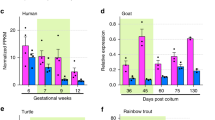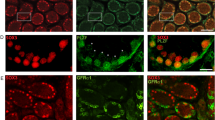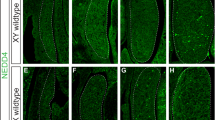Abstract
Heterozygous mutations in SOX9 lead to a human dwarfism syndrome, Campomelic dysplasia. Consistent with a role in sex determination, we find that Sox9 expression closely follows differentiation of Sertoli cells in the mouse testis, in experimental sex reversal when fetal ovaries are grafted to adult kidneys and in the chick where there is no evidence for a Sry gene. Our results imply that Sox9 plays an essential role in sex determination, possibly immediately downstream of Sry in mammals, and that it functions as a critical Sertoli cell differentiation factor, perhaps in all vertebrates.
This is a preview of subscription content, access via your institution
Access options
Subscribe to this journal
Receive 12 print issues and online access
$209.00 per year
only $17.42 per issue
Buy this article
- Purchase on Springer Link
- Instant access to full article PDF
Prices may be subject to local taxes which are calculated during checkout
Similar content being viewed by others
References
Koopman, P., Gubbay, J., Vivian, N., Goodfellow, P.N. & Lovell-Badge, R. Male development of chromosomally female mice transgenic for Sry. Nature 351, 117–121 (1991).
Lovell-Badge, R. & Hacker, A. The molecular genetics of Sry and its role in mammalian sex determination. Phil. Trans. R. Soc. Lond. B., Bio. Sci. 305, 205–214 (1995).
Sinclair, A.H. et al. A gene from the human sex-determining region encodes a protein with homology to a conserved DMA-binding motif. Nature 346, 240–244 (1990).
Gubbay, J. et al. A gene mapping to the sex-determining region of the mouse Y chromosome is a member of a novel family of embryonically expressed genes. Nature 346, 245–250 (1990).
Harley, V.R. et al. DNA binding activity of recombinant SRY from normal males and XY females. Science. 255, 453–456 (1992).
Pontiggia, A. et al. Sex reversing mutations affect the architecture of SRY-DNA complexes. EMBO J. 13, 6115–6124 (1994).
Koopman, P., Munsterberg, A., Capel, B., Vivian, N. & Lovell-Badge, R. Expression of a candidate sex-determining gene during mouse testis differentiation. Nature. 348, 450–452 (1990).
Jeske, Y.W., Bowles, J., Greenfield, A. & Koopman, P. Expression of a linear Sry transcript in the mouse genital ridge. Nature Genet. 10, 480–482 (1995).
Hacker, A., Capel, B., Goodfellow, P.N. & Lovell-Badge, R. Expression of Sry, the mouse sex determining gene. Development 121, 1603–1614 (1995).
Palmer, S.J. & Burgoyne, P.S. In situ analysis of fetal, prepuberal and adult XX–XY chimaeric mouse testes: Sertoli cells are predominantly, but not exclusively, XY. Development 112, 265–268 (1991).
McLaren, A. Germ cells and germ cell sex. Phil. Trans. R. Soc. Lond. B. 350, 229–233 (1995).
Karl, J. & Capel, B. Three-dimensional structure of the developing mouse genital ridge. Phil. Trans. R. Soc. Lond. B. 350, 235–242 (1995).
Buehr, M., Gu, S. & McLaren, A. Mesonephric contribution to testis differentiation in the fetal mouse. Development. 117, 273–281 (1993).
Merchant Larios, H., Moreno Mendonza, N. & Buehr, M. The role of the mesonephros in cell differentiation and morphogenesis of the mouse fetal testis. Int. J. Dev. Biol. (1993).
Jost, A., Vigier, B. & Prepin, J. Freemartins in cattle, the first steps of sexual organogenesis. J. Rep. Fertil. 29, 349–379 (1972).
Behringer, R.R., The Mullerian inhibitor and mammalian sexual development. Phil. Trans. R. Soc. Lond. B. 350, 285–289 (1995).
McElreavey, K., Vilain, E., Cotinot, C., Payen, E. & Fellous, M. Control of sex determination in animals. Eur. J. Bioch. 218, 769–783 (1993).
Berkovitz, G.D., Fechner, P.Y., Marcantonio, S.M., Bland, G. & Stetten, G. The role of the sex-determinig region of the Y chromosome (SRY) in the etiology of 46, XX true hermaphroditism. Hum. Genet. 88, 411–416 (1992).
Meyers-Wallen, V.N. et al. Sry-negative XX sex reversal in the german shorthaired pointer dog. J. Hered. 86, 369–374 (1995).
Just, W. et al. Absence of Sry in species of the vole Ellobius. Nature Genet. 11, 117–118 (1996).
Vigier, B., Watrin, F. Magre, S., Tran, D. & Josso, N. Purified bovine AMH induces a characteristic freemartin effect in fetal rat prospective ovaries exposed to it in vitro. Development 100, 43–55 (1987).
Taketo, T. & Merchant-Larios, H. gonadal sex reversal of fetal mouse ovaries following transplantation into adult mice. In Prog. Dev. Biol., part A. 171–174 (1986).
Graves, J.A.M. The evolution of mammalian sex chromosomes and the origin of sex determining genes. Phil. Trans. R. Soc. Lond. B. 350, 305–312 (1995).
Collignon, J. et al. A comparison of the properties of Sox-3 with Sry and two related genes, Sox-1 and Sox-2. Development. 122, 509–520 (1996).
Krishan, A., Haiden, G.J. & Shaffner, R.N. Mitotic chromosomes and the W sex chromosome of the great horned owl (Bubo v. virgianus). Chromosoma. 17, 258–263 (1965).
Ohno, S.K., W.D. & Kinosita, R. On the sex chromatin of Gallus domesticus. Exp. Cell Res. 19, 180–183 (1960).
Johnston, C.M., Barnett, M. & Sharpe, P.T. The molecular biology of temperature-dependent sex determination. Phil. Trans. R. Soc. Lond. 350, 297–304 (1995).
Foster, J.W. et al. Campomelic dysplasia and autosomal sex reversal caused by mutations in an SRY-related gene. Nature. 372, 525–530 (1994).
Wagner, T. et al. Autosomal sex reversal and campomelic dysplasia are caused by mutations in and around the SRY-related gene SOX9. Cell 79, 1111–1120 (1994).
Wright, E. et al. The Sry-related gene Sox9 is expressed during chondrogenesis in mouse embryos. Nature Genet. 9, 15–20 (1995).
Kwok, C. et al. Mutations in Sox9, the gene responsible for Campomelic dysplasia and autosomal sex reversal. Am. Hum. Genet. 57, 1028–1036 (1995).
Foster, J.W. & Graves, J.A., An SRY-related sequence on the marsupial X chromosome: implications for the evolution of the mammalian testis determining gene. Proc. Natl. Acad. Sci. USA 91, 1927–1931 (1994).
Swain, A., Zanaria, E., Hacker, A., Lovell-Badge, R. & Camerino, G., Mouse Dax1 expression is consistent with a role in sex determination as well as in adrenal and hypothalamus function. Nature Genet. 12, 404–409 (1996).
Shen, W.-H. et al. Nuclear receptor steroidigenic factor 1 regulates the Mullerian inhibiting substance gene: a link to the sex determination pathway. Cell 77, 651–661 (1994).
Coriat, A.M., Valleley, E., Ferguson, M.W. & Sharpe, P. Chromosomal and temperature-dependent sex determination: the search for a conserved mechanism. J. Exp. Zool. 270, 112–116 (1994).
Taketo-Hosotani, T., Merchant-Larios, H., Thau, R.B. & Koide, S.S. Testicular cell differentiation in fetal mouse ovaries following transplantation into adult male mice. J. Exp. Zool. 236, 229–237 (1985).
Houston, C.S. et al. The Campomelic syndrome: review, report of 17 cases, and follow-up on the currently 17-year-old boy first reported by Maroteaux et al. in 1971. Am. J. Med. Genet. 3–28 (1983).
Elbrecht, A. & Smith, R.G. Aromatase enzyme activity and sex determination in chickens. Science. 225, 467–470 (1992).
Travis, A., Amsterdam, A., Belanger, C. & Grosschedl, R. LEF-1, a gene encoding a lymphoid-specific protein with an HMG domain, regulates T-cell receptor alpha enhancer function. Genes Dev. 5, 880–894 (1991).
Whitfield, S., Lovell-Badge, R. & Goodfellow, P.N. Rapid sequence evolution of the the sex determining gene SRY. Nature 364, 713–715 (1993).
Sudbeck, P., Schmitz, M.L., Baeuerle, P.A. & Scherer, G. Sex reversal by loss of the C-terminal transactivation domain of human SOX9. Nature Genet. 13, 230–232 (1996).
Haqq, C.M. et al. Molecular basis of mammalian sexual determination: activation of Mullerian inhibiting substance gene expression by SRY. Science 266, 1494–1500 (1994).
Eusebe, D.C. et al. Cloning and expression of the chick anti-Mullerian hormone gene. J. Biol. Chem. 271, 4798–4804 (1996).
Bitgood, M.J., Shen, L. & Mc-Mahon, A.P. Sertoli cell signaling by Desert Hedgehog regulates the male germline. Current Biol. 6, 298–304 (1996).
Bardoni, B. et al. A dosage sensitive locus at chromosome Xp21 is involved in male to female sex reversal. Nature Genet. 7, 497–501 (1994).
Capel, B. et al. Deletion of Y chromosome sequences located outside the testis determining region can cause XY female sex reversal. Nature Genet. 5, 301–307 (1993).
Laval, S.H. et al. Y chromosome short arm-Sxr recombination in XSxr/Y males causes deletion of Rbm and XY female sex reversal. Proc. Natl. Acad. Sci. USA 92, 10403–10407 (1995).
Luo, X. et al. A cell-specific nuclear receptor is essential for adrenal and gonadal development and sexual differentiation. Cell 77, 481–490 (1994).
Kreidberg, J.A. et al. Wt-1 is required for early kidney development. Cell 74, 679–691 (1993).
Hunt, P.A. & Eicher, E.M. Fertile male mice with three chromosomes: evidence that infertility in XYY male mice is an effect of two chromosomes. Chromosoma. 100, 293–299 (1991).
Lovell-Badge, R.H. & Robertson, E. XY female mice resulting from a heritable mutation in the murine primary testis determining gene. Tdy. Development 109, 635–646 (1990).
Mahadevaiah, S.K., Lovell-Badge, R. & Burgoyne, P.S. Tdy-negative XY, XXY, XYY female mice: breeding data and synaptonemal complex analisys J. Reprod. Fert. 97, 151–160 (1993).
Hamburger, V. & Hamilton, H.L. A series of normal stages in the development of the chick embryo. J. Morphol. 88, 49–92 (1951).
Clinton, M. A rapid protocol for sexing chick embryos (Gallus g.domesticus). Anim Genet. 25, 361–362 (1994).
Chomczynski, P. & Sacchi, N. Single-step method of RNA isolation by acid guanidinium thiocyanate-phenol-chloroform extraction. Anal. Bioch. 162, 156–159 (1987).
Dresser, W.D., Hacker, A., Lovell-Badge, L. & Guerrier, D. The genes for a spliceosome protein (SAP62) and the anti-mullerian hormone (AMH) are contiguous. Hum. Mol. Genet. 4, 1613–1618 (1995).
Wilkinson, D. & Nieto, A.M. in Guide to techniques in mouse development. (P. M. de wassarman & M. L DePamphilis) 361–372 (Academic Press, New York, 1993).
Harlow, E. & Lane, D. Antibodies: a laboratory manual. (Cold Spring Harbor Laboratory, Cold Spring Harbour, 1988).
Author information
Authors and Affiliations
Corresponding author
Rights and permissions
About this article
Cite this article
da Silva, S., Hacker, A., Harley, V. et al. Sox9 expression during gonadal development implies a conserved role for the gene in testis differentiation in mammals and birds. Nat Genet 14, 62–68 (1996). https://doi.org/10.1038/ng0996-62
Received:
Accepted:
Issue Date:
DOI: https://doi.org/10.1038/ng0996-62
This article is cited by
-
UHRF1 establishes crosstalk between somatic and germ cells in male reproduction
Cell Death & Disease (2022)
-
Pubertal development in 46,XY patients with NR5A1 mutations
Endocrine (2022)
-
A framework for high-resolution phenotyping of candidate male infertility mutants: from human to mouse
Human Genetics (2021)
-
Estrogen suppresses SOX9 and activates markers of female development in a human testis-derived cell line
BMC Molecular and Cell Biology (2020)
-
Expression profiling of sexually dimorphic genes in the Japanese quail, Coturnix japonica
Scientific Reports (2020)



